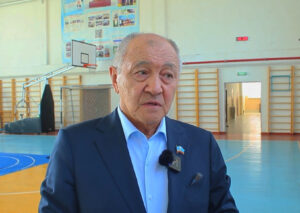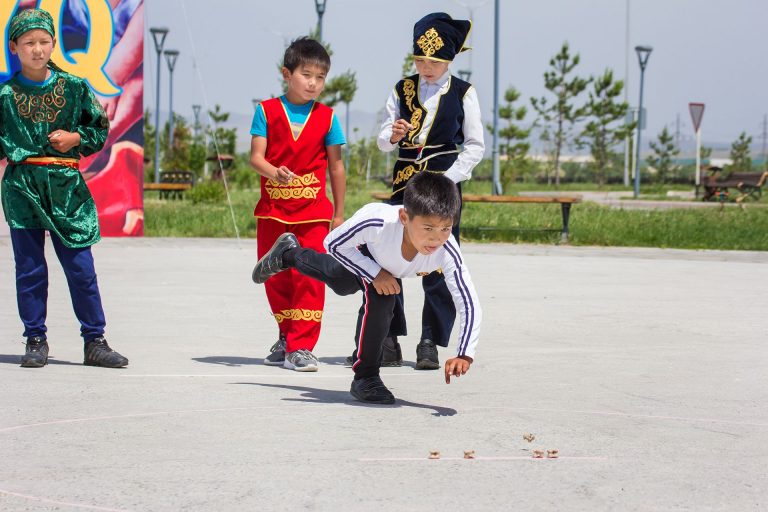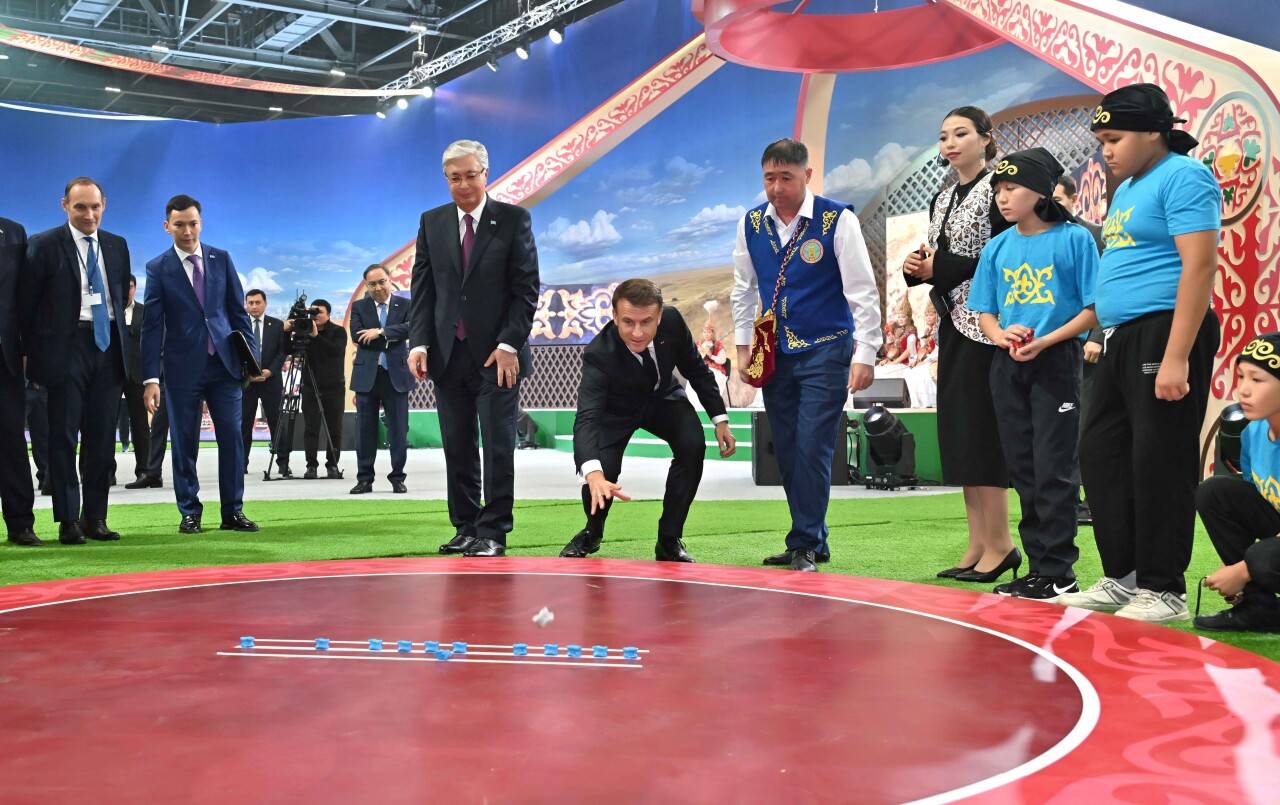ASTANA—Requiring good marksmanship and tactics, the Kazakh traditional game of assyk (knucklebone) is one of the oldest and most popular outdoor nomadic games. The Astana Times interviewed Zhomart Sabyrzhanuly, founding president and executive director of Kazakhstan’s Assyk Federation, about the game’s cultural significance and preparations for the upcoming fifth World Nomad Games.

The ancient nomadic assyk game demands considerable skill in marksmanship. Photo credit: Samruk Kazyna/egemen.kz
Sabyrzhanuly’s significant pioneering work in defining the rules of the game and popularizing it laid the foundations for the establishment of the federation. Widely played at festive celebrations and gatherings, assyk atu (knocking out assyks) was established as a sport in 2011. Later, in 2017, the assyk game was included in the United Nations Educational, Scientific and Cultural Organization (UNESCO)’s Intangible Cultural Heritage list.
“Out of 20 regions of Kazakhstan, we opened an assyk federation in 17 of them. Currently, 90,000 children in Kazakhstan are engaged in this sport and around 1,200 coaches are training them. Thanks to that, we have now trained more than 70 masters of sports,” said Sabyrzhanuly, highlighting how popular the game is becoming.
Game rules
The word “assyk” refers to a small bone connecting the tibia and the shin of a sheep or a similar animal. Depending on its size and position, assyks can have various names.

Zhomart Sabyrzhanuly, executive director of Kazakhstan’s Assyk Federation. Photo credit: astanatimes.com
Before the game, 15 assyks are arranged in the center of a circle four meters in diameter. Players take turns trying to knock out the assyks, and the first player to collect eight of them wins.
“Depending on age, there are fields with diameters of four, five and six meters. When a player shoots the assyk his goal is to knock out the lined up assyks outside the circle. If he succeeds, then the player is allowed to shoot from the border of circle, a closer position. It is called an opportunity,” Sabyrzhanuly explained further.
The ancient nomadic game is easy to learn but difficult to master. It demands considerable skill in marksmanship, requiring players to shoot precisely at the assyk from a distance of five meters.
For centuries, assyk had a great cultural significance for the Kazakh people, as reflected in many sayings associated with it.
“Poet Magzhan Zhumabayev said that playing assyk is a fundamental life experience for a child. Assyk is not merely a bone connecting marrows of a sheep, it is a bone that holds significant value for our people through centuries. It is reflected in many sayings in our culture that involve assyk: for example, they say let your assyk flip as alshy (name of a certain position), which is a wish of luck for a person, or they describe someone as ‘sakadai sai,’ meaning as ready and complete,” said Sabyrzhanuly.
Assyk’s social impact
In a time when children’s entertainment has been delegated to computers and smartphones, assyk games offer a great alternative that involves social interaction and outdoor activity. When children play real games, their senses are heightened, the body and mind become alert, and they develop social and intellectual skills.

Assyk game provides a great opportunity for children to interact and spend time outdoors. Photo credit: e-history.kz
“The beauty of the assyk game is that it is a wonderful exercise that improves sensitivity and motility of hands. There are studies proving that well-developed hands’ mobility positively affects brain function. Second, assyk is a field game, so it involves going out for fresh air and playing in the fields. Then, there will be a lot of body movements. We did an experiment, and it turned out that a child walks 13,000-14,000 steps in one game, which means he covers around 10 kilometers in 45 minutes,” said Sabyrzhanuly.
It is also common knowledge that games on tablets, where eyeballs remain glued to screens for a long time, are harmful to eyesight.
“Now, when our children often spend their time staring at a TV or an iPad, the game provides a good alternative and prevents from developing bad eyesight. This is an indispensable sport for improving eye muscles as well,” he added.
The advantages of assyk games over computer games are many. For one thing, they require minimal investment in money and equipment.
“As our President has noted, we should develop sports that require less financial investment. This includes our assyk. Simply put your assyks in your pocket and head outside – you don’t even need a special big space to play it,” said Sabyrzhanuly.
Preparation for World Nomad Games
The sports hall of a school in southwest Astana may seem an unlikely venue for training the best assyk players. But here, on a Sunday afternoon, a vigorous practice for the upcoming fifth World Nomad Games scheduled for September in Astana is taking place. The hall echoes with a cacophony as players sharpen their skills and reflexes.

French President Emmanuel Macron joined the assyk game during his visit to Kazakhstan in November 2023. Photo credit: akorda.kz
One of them is Yessen Zhumagulov, winner of Kazakhstan’s Assyk Championship, who has been playing assyk since childhood and set a record in the game for Kazakhstan. While a standard assyk game is played for 15 minutes, Zhumagulov knocked out eight out of 15 assyks in just 54 seconds.
“I began playing assyk as a sport in 2016. I first participated in an assyk competition held in front of the Nur-Astana mosque, where I won first place. Since then, I have been playing assyk regularly. I enjoy that it involves running, and it is a great way to stay healthy. Now, people from the age of five to the 70-year-old grandfather play the assyk game,” said Zhumagulov.
According to another player, Nurbakhyt Myntore, the more complex throws require considerable skill.
“Assyk gives you maneuver and temp. That’s why I like it. Tactics and marksmanship are needed to win in assyk,” said Myntore, who is a three-time winner of Kazakhstan’s Assyk Championship among youth and silver medalist of the Asian Championship.
Sabyrzhanuly cited the federation’s statistics that around 13,000-14,000 people join the assyk game each year. “The popularity of the game is increasing. Schools are increasingly willing to include assyk into school curricula,” he said. This gives him hope that the federation will train talented players who can represent Kazakhstan at the World Nomad Games.


